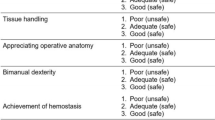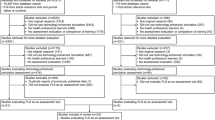Abstract
Background
Laparoscopic incisional hernia repair (LIHR) is a common procedure requiring advanced laparoscopic skills. This study aimed to develop a procedure-specific tool to assess the performance of LIHR and to evaluate its reliability and validity.
Methods
The Global Operative Assessment of Laparoscopic Skills-Incisional Hernia (GOALS-IH) is a 7-item global rating scale developed by experts to evaluate the steps of LIHR (placement of trocars, adhesiolysis, estimation of mesh size and shape, mesh orientation and positioning, mesh fixation, knowledge and autonomy in use of instruments, overall competence), each rated on a 5-point Likert scale. During LIHR, 13 attending surgeons and fellows experienced in minimally invasive surgery (MIS) and 19 novice surgeons (postgraduate years [PGYs], 3–5) were evaluated at four teaching hospitals by the attending surgeon, a trained observer, and self-assessment using GOALS-IH, and by a previously validated 5-item general laparoscopic rating scale (GOALS). Interrater reliability was assessed by intraclass correlation (ICC), and internal consistency of rating items was assessed by Cronbach’s alpha. Known-groups construct validity was assessed by using the t-test and by correlating of the number of self-reported LIHR cases with the total score. Concurrent validity was assessed by correlating the GOALS-IH score with the GOALS general rating scale. Data are presented as mean and 95% confidence interval (CI).
Results
Interrater reliability for the total GOALS-IH score was 0.79 (95% CI, 0.60–0.89) between observers and attending surgeons, 0.81 (95% CI, 0.58–0.92) between participants and attending surgeons, and 0.89 (95% CI, 0.76–0.96) between participants and observers. Internal consistency was high (Cronbach’s alpha, 0.93). Experienced surgeons performed significantly better than novices as assessed by GOALS-IH (31; 95% CI, 29–33 vs. 21; 95% CI, 19–24; p < 0.01). Very good correlation was found between GOALS-IH and previous LIHR experience (r = 0.82; p < 0.01) and strong correlation between GOALS-IH and generic GOALS total scores (r = 0.90; p < 0.01).
Conclusion
Surgical performance during clinical LIHR can be assessed reliably using GOALS-IH. Results can be used to provide formative feedback to the surgeon and to identify steps of the operation that would benefit from specific educational interventions.




Similar content being viewed by others
References
Heniford BT, Park A, Ramshaw BJ, Voeller G (2003) Laparoscopic repair of ventral hernias: nine years’ experience with 850 consecutive hernias. Ann Surg 238:391–399
Bageacu S, Blanc P, Breton C, Gonzales M, Porcheron J, Chabert M, Balique JG (2002) Laparoscopic repair of incisional hernia: a retrospective study of 159 patients. Surg Endosc 16:345–348
Bencini L, Sanchez LJ (2004) Learning curve for laparoscopic ventral hernia repair. Am J Surg 187:378–382
Leblanc KA, Elieson MJ, Corder JM III (2007) Enterotomy and mortality rates of laparoscopic incisional and ventral hernia repair: a review of the literature. JSLS 11:408–414
Sturm LP, Windsor JA, Cosman PH, Cregan P, Hewett PJ, Maddern GJ (2008) A systematic review of skills transfer after surgical simulation training. Ann Surg 248:166–179
Sroka G, Feldman LS, Vassiliou M, Kaneva PA, Fayez R, Fried GM (2010) Fundamentals of laparoscopic surgery simulator training to proficiency improves laparoscopic performance in the operating room: a randomized controlled trial. Am J Surg 199:115–120
Vassiliou MC, Feldman LS, Andrew CG, Bergman S, Leffondré K, Stanbridge D, Fried GM (2005) A global assessment tool for evaluation of intraoperative laparoscopic skills. Am J Surg 190:107–113
Gumbs AA, Hogle NJ, Fowler DL (2007) Evaluation of resident laparoscopic performance using global operative assessment of laparoscopic skills. J Am Coll Surg 204:308–313
Gallagher AG, Ritter EM, Champion H, Higgins G, Fried MP, Moses G, Smith CD, Satava RM (2005) Virtual reality simulation for the operating room: proficiency-based training as a paradigm shift in surgical skills training. Ann Surg 241:364–372
Scott DJ, Dunnington GL (2008) The new ACS/APDS Skills Curriculum: moving the learning curve out of the operating room. J Gastrointest Surg 12:213–221
Tsuda S, Scott D, Doyle J, Jones DB (2009) Surgical skills training and simulation. Curr Prob Surg 46:261–372
Martin JA, Regehr G, Reznick R, MacRae H, Murnaghan J, Hutchison C, Brown M (1997) Objective structured assessment of technical skill (OSATS) for surgical residents. Br J Surg 84:273–278
Reznick RK, Regehr G, MacRae HM, Martin J (1997) Testing technical skill via an innovative bench station examination. Am J Surg 173:226–230
Anastakis DJ, Regehr G, Reznick RK, Cusimano M, Murnaghan J, Brown M, Hutchison C (1999) Assessment of technical skills transfer from the bench training model to the human model. Am J Surg 177:167–170
Vassiliou MC, Feldman LS, Fraser SA, Charlebois P, Chaudhury P, Stanbridge DD, Fried GM (2007) Evaluating intraoperative laparoscopic skill: direct observation versus blinded videotaped performances. Surg Innov 14:211–216
McCluney AL, Vassiliou MC, Kaneva PA, Cao J, Stanbridge DD, Feldman LS, Fried GM (2007) FLS simulator performance predicts intraoperative laparoscopic skill. Surg Endosc 21:1991–1995
Seymour NE, Gallagher AG, Roman SA, O’Brien MK, Andersen DK, Satava RM (2004) Analysis of errors in laparoscopic surgical procedures. Surg Endosc 18:592–595
Acknowledgment
The authors thank Drs. Carlos Godinez, Ajita Prabhu, and Todd Heniford for their help in data collection and coordination during the study. This study is supported by a research grant from the Canadian Association of General Surgeons (CAGS). The Steinberg-Bernstein Centre is supported by an unrestricted educational grant from Covidien Canada.
Disclosure
Iman Ghaderi received salary support from the Postgraduate Medical Education office at the University of Western Ontario. Marilou Vaillancourt, Gideon Sroka, Pepa A. Kaneva, Melina C. Vassiliou, Ian Choy, Allan Okrainec, F. Jacob Seagull, Erica Sutton, Ivan George, Adrian Park, Rita Brintzenhoff, Dimitrios Stefanidis, Gerald M. Fried, and Liane S. Feldman have no conflicts of interest or financial ties to disclose.
Author information
Authors and Affiliations
Corresponding author
Rights and permissions
About this article
Cite this article
Ghaderi, I., Vaillancourt, M., Sroka, G. et al. Evaluation of surgical performance during laparoscopic incisional hernia repair: a multicenter study. Surg Endosc 25, 2555–2563 (2011). https://doi.org/10.1007/s00464-011-1586-4
Received:
Accepted:
Published:
Issue Date:
DOI: https://doi.org/10.1007/s00464-011-1586-4




